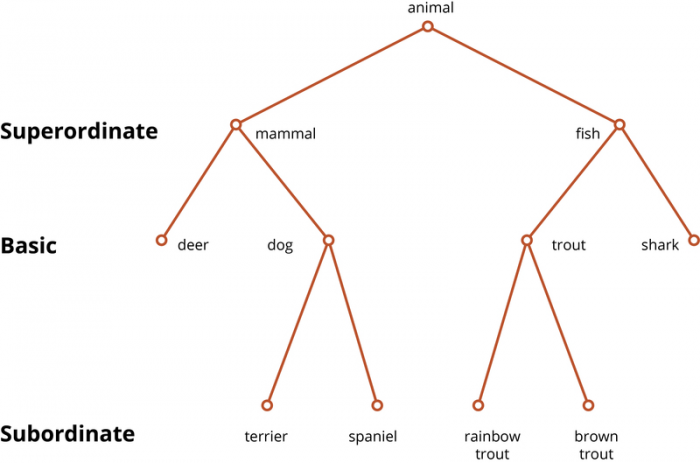Thinking
The way we represent the world influences the degree of success we experience in our lives. For example, if we represent yellow traffic lights as the time to hit the accelerator, then the world might give us tickets, scares, or accidents. If we represent our diet as a way to maximize refined sugar intake, then we might wind up experiencing heart disease. Mental representations and intelligence go hand in hand. Some mental representations are more intelligent, because they are more adaptive and support outcomes such as well-being, safety, and success. In this section we are going to cover other elements of thinking like categorization, memory, and intelligence and how culture shapes these processes.
Categories and Concepts
The information we sense and perceive is continuously organized and reorganized into concepts that belong to categories. Most concepts cannot be strictly defined but are organized around the best examples or prototypes, which have the properties most common in the category or might be considered the ideal example of a category.
Concepts are at the core of intelligent behavior. We expect people to be able to know what to do in new situations and when confronting new objects. If you go into a new classroom and see chairs, a blackboard, a projector, and a screen, you know what these things are and how they will be used. You’ll sit on one of the chairs and expect the instructor to write on the blackboard or project something onto the screen. You’ll do this even if you have never seen any of these particular objects before, because you have concepts of classrooms, chairs, projectors, and so forth that tell you what they are and what you’re supposed to do with them.
Objects fall into many different categories, but there is usually a hierarchy to help us organize our mental representations.
- A concept at the superordinate level of categories is at the top of a taxonomy and it has a high degree of generality (e.g., animal, fruit).
- A concept at the basic level categories is found at the generic level which contains the most salient differences (e.g., dog, apple).
- A concept at the subordinate level of categories is specific and has little generality (e.g., Labrador retriever, Gala).

Brown (1958) noted that children use basic level categories when first learning language and superordinates are especially difficult for children to fully acquire. People are faster at identifying objects as members of basic-level categories (Rosch et al., 1976). Recent research suggests that there are different ways to learn and represent concepts and that they are accomplished by different neural systems. Using our earlier example of a classroom, if someone tells you a new fact about the projector, like it uses a halogen bulb, you are likely to extend this fact to other projectors you encounter. In short, concepts allow you to extend what you have learned about a limited number of objects to a potentially infinite set of events and possibilities.
Categorization and Culture
There are some universal categories like emotions, facial expressions, shape and color but culture can shape how we organize information. Chiu (1972) was the first to examine cultural differences in categorization using Chinese and American children. Participants were presented with three pictures (e.g., a tire, a car, and a bus), and were asked to group the two pictures they thought best belonged together. Participants were also asked to explain their choices (e.g., “Because they are both large”). Results showed that the Chinese children have a greater tendency to categorize by identifying relationships among the pictures but American children were more likely to categorize by identifying similarities among pictures.
Later research reported no cultural differences in categorization between Western and East Asian participants; however, among similarity categorizations the East Asian participants were more likely to make decisions on holistic aspects of the images and Western participants were more like to make decisions based on individual components of the images (Norenzayan, Smith, Jun Kim, and Nisbett, 2002). Cultural differences in categorizing were also found by Unworth, Sears and Pexman (2005) across three experiments; however, when the experiment task was timed there were differences in category selection. These results suggest that the nature (timed or untimed) of the categorization task determines the extent to which cultural differences are observed.
The results of these categorization studies seem to support the differences in thinking between individualist and collectivist cultures. Western cultures are more individualist and engage in more analytic thinking and East Asian cultures engage in more holistic thinking (Choi, Nisbett, & Smith, 1997; Masuda & Nisbett, 2001; Nisbett et al., 2001; Peng & Nisbett, 1999). You might remember from the earlier section that holistic thought is characterized by a focus on context and environmental factors so categorizing by relationships can be explained with referencing how objects relate to their environment. Analytic thought is characterized by the separation of an object from its context so categorizing by similarity means that objects can be separated into different groups. A major limitation with these studies is the emphasis on East Asian, specifically the use of Chinese participants and Western cultures. There have been no within culture replications using participants from other non-Asian collectivist cultures.

